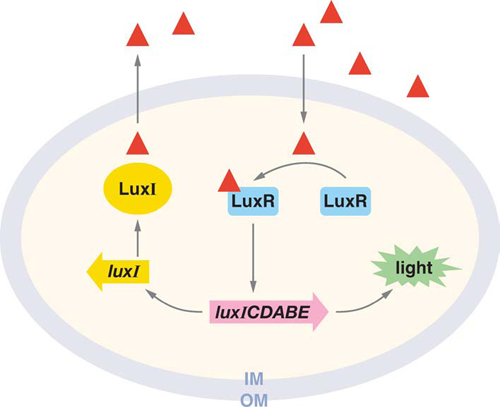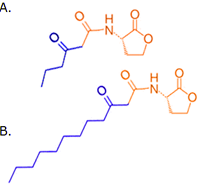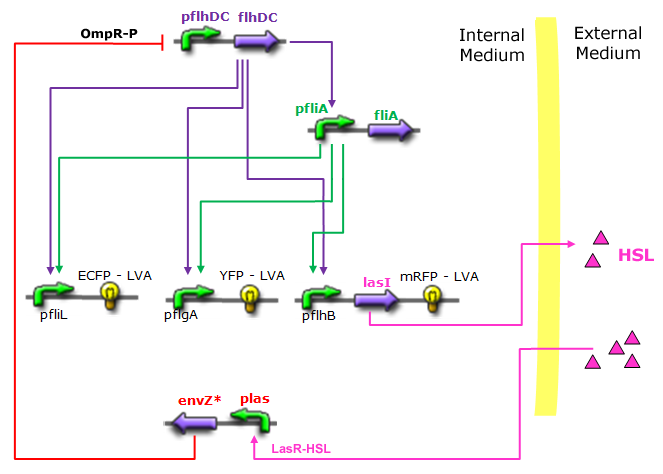 The Hawaiian bobtail squid have a symbiotic relationship with Vibrio fischeri Presentation of the phenomenon of quorum-sensing : intercellular communication in bacterias
The phenomenon of quorum sensing was first discovered in Vibrio fischeri. This bacteria only expresses luciferase when the density of bacteria is very high (1011bact/mL). Typically, the bacteria does not express bioluminescence when they are free living in the ocean. At the contrary, they express luciferase when they are highly concentrated in the photophore of Hawaiian bobtail squid.
 Fig 1 : Quorum sensing in V. fischeri. (Red triangle represent AHL produced by LuxI. OM : Outer Membrane, IM : Inner Membrane The genetic cascade
In this system, LuxI and LuxR control the expression of luciferase operon luxICDABE, necessary to produce bioluminescence. LuxI synthesize small diffusible molecules called Acyl Homoserin Lactone (AHL). LuxR is the intracellular receptor to AHL.
The AHL freely diffuses into the extracellular medium. Its concentration increases as the population gets more dense. When the concentration reaches a critical level, those small molecules bind to their receptor. LuxR bound to AHL and the complex activate the operon that code for luciferase (Figure 1.).
Quorum Sensing and Synthetic biology
This system has already been used in the field of synthetic biology to create new behaviors. For instance, [http://www.nature.com/nature/journal/v428/n6985/abs/nature02491.html Lingchong YOU et al. (2004)] designed a bacteria that regulates the maximum density of bacteria inducing a controlled suicide via intercellular communication. With this system, even if the population is stable the genome is expressed as if they were in exponential growth.
 Fig 2 : Structure of two different AHL. In orange the common part to all AHL. A : 3OC6-HSL synthesized by LuxI. B : 3OC1-HSL synthesized by LasI Other quorum sensing systems has been described in different species of baceteria such as Pseudomonas aeruginosa. The system has the same architecture with protein LasI that synthesize the AHL that binds to LasR, the intracellular receptor. One of the differences between those to systems is the structure of the AHL (Figure 2.)
The use of two quorum sensing system is possible. This is one of the challenges that [http://www.ncbi.nlm.nih.gov/sites/entrez/18414488?dopt=Abstract&holding=f1000,f1000m,isrctn Frederick K. BALAGADDE et al. (2008)] carried out successfully. They constructed a synthetic ecosystem that imitates the prey-predator relationship in two different strains of E. coli.
Bibliography
- [http://www.ncbi.nlm.nih.gov/pubmed/7809088?ordinalpos=2&itool=EntrezSystem2.PEntrez.Pubmed.Pubmed_ResultsPanel.Pubmed_DefaultReportPanel.Pubmed_RVDocSum Stevens et al. 1994)]
- [http://www.nature.com/nature/journal/v428/n6985/abs/nature02491.html You et al. (2004)]
- [http://www.ncbi.nlm.nih.gov/pubmed/16212498 Waters et al. (2005)]
- [http://www.ncbi.nlm.nih.gov/sites/entrez/18414488?dopt=Abstract&holding=f1000,f1000m,isrctn Baladaddé et al. (2008)]
|  "
"






